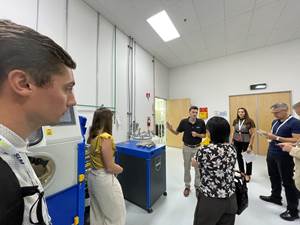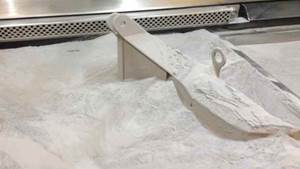Video: “I Think You Ignore Additive Manufacturing at Your Peril”
I check in with Greg Morris of GE Additive, hearing his views on AM’s continuing promise and importance. Representatives of John Deere, Smith & Nephew, B&J Specialty and Tangible Solutions share their views on the same question.
At the most recent Additive Manufacturing Conference, I was on stage with Greg Morris of GE Additive and I asked him a simple question: Is additive manufacturing for real? That is, is the attention justified? Where are we headed with AM and how seriously should manufacturers take it? In this video, he makes the case (or re-makes the case, because he has made it many times) for the importance and the disruptive promise of AM. Then he and I bring other users to the stage, and they share their views as well.
Transcript:
Peter Zelinski, Additive Manufacturing
I guess I don’t mean this entirely tongue-in-cheek, but is this additive stuff really for real? It took years and years to develop the fuel nozzle, a very early additive success to be sure. There are real challenges in getting a sophisticated part into repetitive production through an additive process. So talk about that. Is it true that the people who’ve invested in coming to this conference are investing their time wisely because this really is headed toward mainstream production?
Greg Morris, GE Additive
So, look, you know I’m a pretty passionate guy about additive, so you know you’re going to get a colored response from me. But I think it’s a fair statement to say that I really struggle sometimes to think of an industry that makes something that isn’t somehow using additive and if they’re not—you know, maybe there’s something out there, but you look at all the different modalities, all the different materials and all the different application points and it’s hard to ignore it. I mean, it’s really hard to suggest that additive is not going to be something that is a major disruptive technology to at least consider in people’s manufacturing processes or industries.
So I pick GE and I say why is GE a litmus test, maybe, for what others will see? It’s because GE is a multinational, very large corporation—it’s a giant industrial company, it gets involved in a lot of different products. Again, from aircraft engines to locomotives to healthcare devices—making CT scanners, oil and gas, you name it. So GE has a very broad industrial base in which it serves. Again, if we are an indication, the proof points we see internally as a corporation—we can clearly identify three to five billion dollars of cost out over the next 10 years. To me, that’s a pretty big number even for a GE. That gets the attention of a lot of people.
So I look at that and I say that’s great, so from the cost out standpoint—I look and say additive is fundamentally making us think about our products differently. So just like the ATP, the advanced turboprop engine, will be 35 percent printed components. That’s a fundamental shift in how our engineers and designers are thinking. When we can take 300 disparate pieces that make up a component of an ATP engine and we can now consolidate that and make one part, you know, you’re thinking on levels that you haven’t thought about before. So I get very passionate about the fact that I think it’s a technology that may not be deeply applicable to every industry or to every company but I think you ignore it at your peril. And I’ve seen too many examples of companies who haven’t realized the gravity of it and they find their competitors have been able to leverage the technology in ways they just didn’t think about.
Peter Zelinski
If you'll stay with me, I'd like to ask some some other succeeding users to come back to the stage.
(Representatives of four other companies applying AM join Morris and Zelinski on the stage.)
Greg Morris
So, look, I think you guys come from different areas. Obviously, we have John Deere, we have Smith & Nephew, B&J Specialty and Tangible Solutions, and you guys have a different background. So, I made a bold statement from a GE lens and GE is a different company than the four of you guys. I’d just like to know each of your thoughts. You know, is Greg out there drinking some kind of Kool Aid that you haven't had yet? Or am I hitting the target, do you think? I mean, how do you view it in your world? Do you see it being as significant as what I was just kind of saying, or do you think that I'm overblowing it, or do you think I'm underestimating it? We’ll just go down the line.
Eric Johnson, John Deere
Sure, so I can take that. Yeah, I think it is going to be a game-changer. It may just be a little bit delayed from the cost curve of what the aerospace will be. I think you probably have similar sizes, maybe not as large structure-wise, but you know maybe that isn't an application that goes forth. But yeah, if I have to put a number to it, I’m not totally sure, but it'll change the game.
Mark Morrison, Smith & Nephew
Yes, so I think that we're not anywhere close to even seeing additive take over subtractive. I think today you need the right application to take advantage of what additive can bring to the table and honestly to tolerate the higher costs that come along with it particularly with metal and all the postprocessing and things like that that come along with it. So it's a matter of finding the right application in your field in my opinion. I think a lot of people that might know just a little bit about additive think we're going to start making everything, we're just going to print everything, and really, it's not feasible and I don't see that being feasible for most things for a very long time.
Jarod Rauch, B&J Specialty
I definitely agree with all those statements. I view additive in the molding environment as just another tool for your arsenal of how you can manufacture. You know, we have all discussed finding the niche, finding that perfect place for it, but if you have an open mind from a designer standpoint, you're much more easily going to be able to apply it to your line of work, whether that's in molding, medical or aerospace work. Additive can be used for about anything if you apply it correctly, and I think that's why a lot of us are so excited for where additive can go in the next five to 10years. But yeah, I mean it's not going to be a replacement for how we typically manufacture things; it's just going to aid us to make that next step.
Adam Clark, Tangible Solutions
Well, I've had two glasses of Kool Aid and I'll probably have a third before I leave today. Obviously, I've staked a lot on it and so have my business partners and our investors and our board. I think what's really interesting that I watch is the maturity of the industry—not necessarily of the technology itself but in terms of companies and processes and delivery. You know, within additive we're starting to see subcomponents and focused groups of companies focusing in on target markets, target products. We started out with two printers in a garage and now today we do 90 percent of our business in titanium implants.
We call ourselves a contract manufacturer of spinal implants and that's our focus. There are other companies out there that do aerospace really well. I think as you start to see that proliferate, you start to see those fourth- to 12th-graders start to enter into the workforce and see more of the technology being used, and it's going to accelerate at an exponential rate that will be difficult to keep up with and I think it's really important that we as a whole, as an industry, come together and prepare for it so we can make it a 76-billion-dollar industry, because it certainly can be.
Related Content
Video: What Is Electron Beam Melting (EBM)?
Electron beam melting is the higher-energy metal 3D printing process offering advantages when it comes to productivity and thermal stresses. Here is an introduction to EBM.
Read MoreThe AM Ecosystem, User Journeys and More from Formnext Forum Austin: AM Radio #43
Sessions and conversations at the first U.S. Formnext event highlighted the complete additive manufacturing ecosystem, sustainability, the importance of customer education, AM user journeys and much more.
Read MoreA Framework for Qualifying Additively Manufactured Parts
A framework developed by The Barnes Global Advisors illustrates considerations and steps for qualifying additively manufactured parts, using an example familiar to those in AM: the 3D printed bottle opener.
Read MorePostprocessing Steps and Costs for Metal 3D Printing
When your metal part is done 3D printing, you just pull it out of the machine and start using it, right? Not exactly.
Read MoreRead Next
Postprocessing Steps and Costs for Metal 3D Printing
When your metal part is done 3D printing, you just pull it out of the machine and start using it, right? Not exactly.
Read More3MF File Format for Additive Manufacturing: More Than Geometry
The file format offers a less data-intensive way of recording part geometry, as well as details about build preparation, material, process and more.
Read MoreHow Avid Product Development Creates Efficiencies in High-Mix, Low-Volume Additive Manufacturing
Contract manufacturer Avid Product Development (a Lubrizol company) has developed strategies to streamline part production through 3D printing so its engineering team can focus on development, design, assembly and other services.
Read More





















